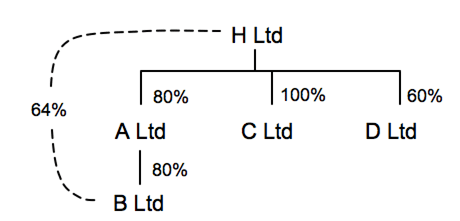Part 3 of 4
This is the Finance Act 2023 version of this article. It is relevant for candidates sitting the ATX-UK exam in the period 1 June 2024 to 31 March 2025. Candidates sitting ATX-UK after 31 March 2025 should refer to the Finance Act 2024 version of this article (to be published on the ACCA website in 2025).
So far we have reviewed the definitions of a group relief group and a capital gains group and considered some aspects of group planning.
The remaining parts of this article continue to examine the tax planning issues relating to group relief groups. This part looks at associated companies, consortia and the carry back of losses. Throughout this review of tax planning issues, the term ‘losses’ will be used to represent any/all tax attributes that can be surrendered via group relief.
Associated companies
All companies in the group relief group will be associates but so will other companies, including companies where the effective ownership is less than 75%, and companies resident overseas (provided there is control). In addition, companies controlled by the same individual(s) even though they are not in a group with the subject company would also be associated. For example, in the H Ltd group from Part 1 of this article (as set out below), all five companies are associated with each other.
Figure 1: The structure of the H Ltd group of companies

When calculating the number of associated companies to determine the rate of corporation tax, companies need only be associated AT SOME POINT IN THE CURRENT accounting period and not for the whole of the accounting period. Accordingly, when determining the number of associated companies in relation to a company that has just joined a group, it is necessary to include any companies with which it was associated prior to the purchase (but during the same accounting period).
However, when determining the number of associated companies to determine whether corporation tax needs to be paid in instalments, companies must be associated companies ON THE LAST DAY OF THE PRECEDING accounting period. Accordingly, when determining the number of associates in relation to a company that has just joined a group, it is necessary to include only those companies which were associates on that day.
Consortia
As a general rule, before starting any calculations in the exam, make sure you have considered all of the possible options. When dealing with group loss planning this means thinking about the possible existence of a consortium. In the group above, D Ltd is not a member of the H Ltd group relief group but that does not necessarily mean that H Ltd cannot surrender losses to D Ltd: it depends on who owns the remainder of D Ltd’s share capital. If companies that each own at least 5%, together own at least 15% (such that they, together with H Ltd, own at least 75%), then D Ltd will be a consortium company. H Ltd would then be able to surrender losses to D Ltd up to a maximum of 60% of D Ltd’s profits.
Group relief and the carry back of losses
Once a company has offset trading losses against its total profits of the current accounting period, it can elect to offset any remaining losses against its total profits of the previous 12 months. Unlike group relief, the offset of losses against a company’s own total profits is an all or nothing claim such that, if there are sufficient losses, taxable profits will be reduced to zero. However, group relief can be used to engineer the carry back of a particular amount of losses in order to offset losses at the highest possible rates of tax as set out in Example 2.
EXAMPLE 2
In the year ended 31 March 2024, UL Ltd has a trading loss of £75,000 and no other income or gains. In the previous year its taxable profits were £52,500. UL Ltd has three wholly owned subsidiaries and therefore its upper limit is £62,500 (£250,000/4) and its lower limit is £12,500 (£50,000/4). The other members of its group relief group pay corporation tax at the main rate.
UL Ltd has profits of £40,000 (£52,500 – £12,500) taxed at the marginal rate in the year ended 31 March 2023. In order to relieve its losses against these profits, whilst avoiding relieving any profits taxed at the small profits rate, UL Ltd will need to submit the following claims.
- Before submitting a claim to carry back losses to the previous year, UL Ltd should surrender losses to other group companies where they will save tax at the main rate. UL Ltd wants to carry back losses of £40,000 and should therefore surrender losses of £35,000 (£75,000 – £40,000).
- UL Ltd should then submit a claim to carry back its remaining losses against the profits of the previous year.
The additional corporation tax saved via the operation of this strategy, as opposed to a surrender of all of the losses to group companies, is £600 (£40,000 x (26.5% – 25%)).
Conclusion
In the exam make sure that you think carefully when identifying the number of associates and whether or not there is the possibility of a consortium.
Note: Corporation tax issues are considered in two further articles:
- Corporation tax for ATX-UK
- Corporation tax – Groups and chargeable gains for ATX-UK
Written by a member of the ATX-UK examining team
The comments in this article do not amount to advice on a particular matter and should not be taken as such. No reliance should be placed on the content of this article as the basis of any decision. The authors and ACCA expressly disclaim all liability to any person in respect of any indirect, incidental, consequential or other damages relating to the use of this article.


